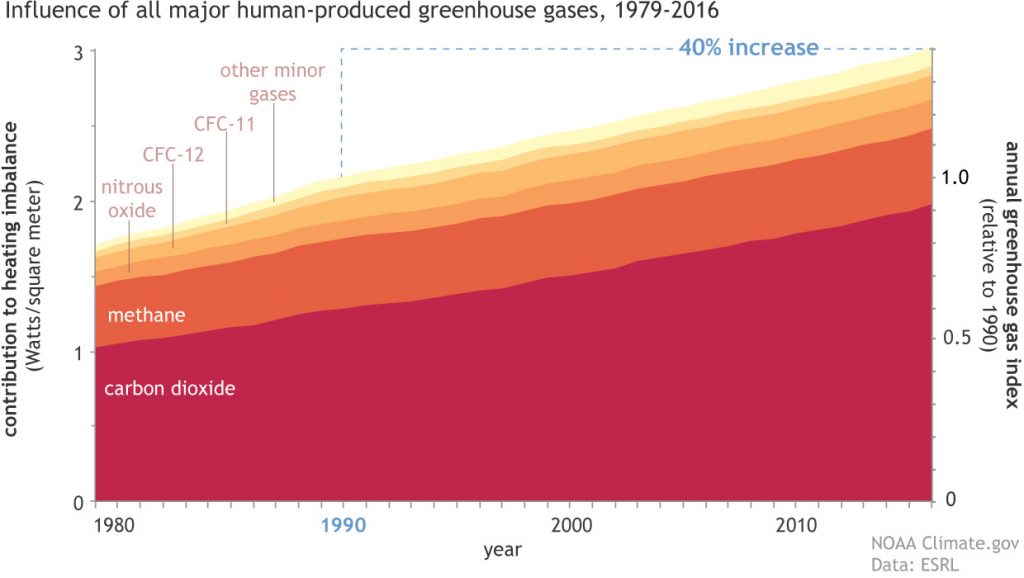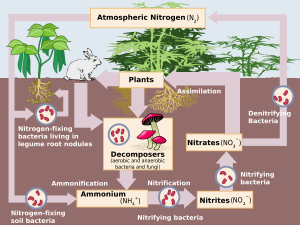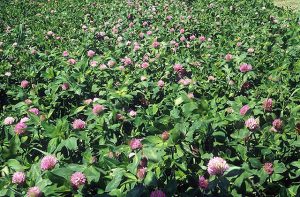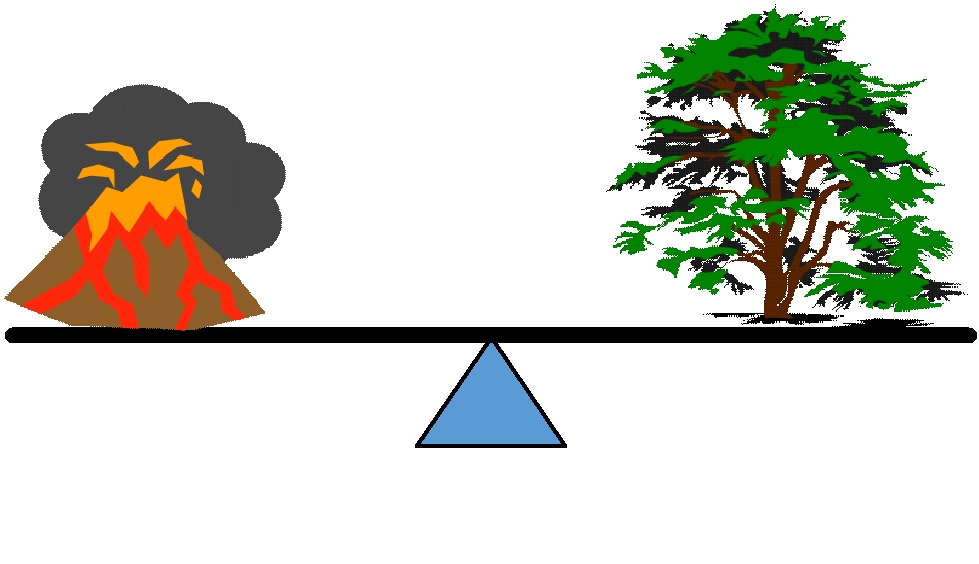
Imagine, for a moment, a seesaw. On one side, put volcanoes, fires, and decomposing plants. On the other side, put trees, oceans, crops, and gardens. This seesaw represents how carbon dioxide enters and leaves the atmosphere. Trees, oceans, soil, and living organisms remove and store carbon dioxide from the atmosphere, while volcanoes, fires, and decomposition all return carbon to the atmosphere. These two sides have been balancing each other for most of human history.
But during the last half century, the carbon dioxide seesaw has been weighed down by the addition of cars, trucks, planes, and burning fossil fuels on the “volcano” side. In other words, we’re putting carbon dioxide into the atmosphere faster than the “trees” side can remove it.
This is often the way that scientists and policy makers talk about climate change: carbon in versus carbon out and how to balance the seesaw. Some researchers suggest that improving our use of existing technology for removing carbon dioxide from the atmosphere can help restore the balance. Agriculture, in particular, represents a promising opportunity since it’s already on the “trees” side of the seesaw. New research, however, suggests that other agriculture-associated greenhouse gases, such as nitrous oxide, could interact with the carbon dioxide balance and lead to a net increase in emissions.
Agriculture Rides the Seesaw (and How It Works)
Recently, the NYT Magazine published an article about how agriculture can potentially help rebalance the seesaw through carbon farming. This is a group of practices that actively manage agricultural land to increase the amount of carbon stored in the soil.
Plants, including crops, remove carbon from the atmosphere and store, or sequester, it in the soil as they grow (this is the basic idea behind reforestation). Some of that carbon is returned to the atmosphere as leaves fall off of trees or plants die.
NASA’s visualization of the annual carbon cycle shows atmospheric carbon dioxide levels are highest in the northern hemisphere’s spring (when there are fewer living plants) and lowest in the autumn (when there are more living plants). If you look closely, you can even see carbon dioxide moving in and out of the atmosphere on a daily basis in the Amazon and Indonesia.
Agriculture, though, is a little more complicated than the carbon cycle in the video.
Annual crops such as wheat and corn take up carbon dioxide as they grow, but not all of that carbon (the “dioxide” helpfully sent back out into the atmosphere for us to breathe) makes it into the soil where we want it. We eat some of that carbon when we harvest the plant, and some of the carbon that ended up in the soil is released back into the atmosphere when we plow the land next year or when it erodes away since there aren’t any plants there to hold it down.
Carbon farming tries to reduce the amount of carbon that leaves the soil by adding cover crops, tilling the land less, and leaving the soil covered, mimicking ecosystems that have high levels of soil carbon such as the Amazon. But carbon dioxide isn’t the only greenhouse gas, and certainly not the only one in agriculture.
What’s Tipping the Scales: Other Greenhouse Gases in Agriculture
Despite the potential for agricultural land to be used as a place to store carbon, carbon dioxide is not the primary greenhouse gas associated with agriculture. Approximately one-quarter of global greenhouse gas emissions come from the agriculture sector, generally as methane or nitrous oxide.
Methane, aka enteric fermentation (cow farts, or more accurately, burps), is about 25-30 times more powerful a greenhouse gas than carbon dioxide. Nitrous oxide—laughing gas—is nearly 300 times more powerful than carbon dioxide and comes from fertilizers as part of the nitrogen cycle. In terms of carbon farming and carbon sequestration, it’s the nitrous oxide that might undo the seesaw’s balancing act.

But how exactly could carbon dioxide and nitrous oxide, two different gases resulting from two different processes, interact so that reducing one would increase the other?
The answer lies not above our heads in the atmosphere, but below our feet in good, old-fashioned dirt.
Nitrogen and Carbon: A Match made in Soil
Nitrogen and carbon move through the atmosphere, plants and other living organisms, and soils. While the two cycles are scientifically complex (nitrogen, in particular), there are a few key processes where they overlap.

Specifically, the part of the nitrogen cycle that’s most important here is denitrification. This process occurs in a low-oxygen environment, when a group of microbes called denitrifiers eat nitrate and produce atmospheric nitrogen, in their quest to find oxygen.
Critically, for our story, the denitrifiers also require a high carbon environment to fuel their activity. The end-game of denitrification is plain nitrogen, but sometimes it doesn’t make it all the way, resulting in nitrous oxide, among other gases.
So why do we have nitrates in the soil? Nitrates are the byproduct of nitrification by a different group of microbes called nitrifiers. Nitrification occurs when there is a source of nutrient nitrogen for the nitrifiers to eat; for example, fertilizer that isn’t taken up by crops.
Nitrification and denitrification can be seen as wasted fertilizer becoming a greenhouse gas, somewhat similar to letting your car idle for hours. Not only is this harmful to the environment, but for farmers, it represents an economic loss, since that fertilizer isn’t going to their crops.
Nitrogen and Carbon: On the Farm

One way that farmers could address this nitrogen inefficiency is by planting legume crops (such as clover) that fix nitrogen into the soil. This would kill two birds with one stone since, while all plants send carbon into the soil, legumes also make more nitrogen available in the soil for the main crop, reducing the need for synthetic fertilizer.
But denitrifiers also require lots of carbon as an energy source. This means that as we increase the amount of carbon in the soil, we could just be providing a huge amount of energy for the denitrifiers. A study published in Nature Climate Change earlier this year found that carbon farming with a legume cover crop (to make up for reduced fertilizer inputs) actually becomes a net greenhouse gas emitter after about fifty years. Plus, the same study showed only very small and gradual carbon sequestration from carbon farming by itself, and certainly much slower than what is necessary to mitigate climate change.
Stay Informed, Citizenry
So, where to from here? Managing greenhouse gases in the atmosphere isn’t as simple as balancing carbon in versus carbon out, yet most of what we talk about when discussing climate change is that carbon dioxide seesaw. Legislators in several states are proposing bills which would encourage farmers to adopt carbon sequestering practices. But does agriculture represent an opportunity to balance the carbon dioxide seesaw, or does nitrous oxide upend the whole system? Stay tuned for more research in this field, but in the meantime, you can call your representatives make sure they’re taking action.

